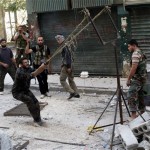
The Syrian Civil War is poised to explode into full scale sectarian violence that will engulf the region as a global proxy war is played out on Syrian soil. Recent news reports cite Iraqi Shia fighters trained by Iran have been joining ranks with Hezbollah militants in Syria. These combined forces are supporting Syrian President Assad’s legitimate government forces against a Syrian rebel army that is comprised mainly of Sunni Muslims. Like the Syrian government’s forces, the rebel army is also comprised of a large contingent of foreign fighters. As we have repeatedly warned, the vanguard rebel fighters are Sunni extremists from around the globe, which include a large contingent of Sunni Iraqis and others waging global jihad. These rebel fighters have sworn allegiance to Al Qaeda, support the Muslim Brotherhood, and have announced that when they are done fighting in Syria, the USA will be next. As such, one would think the US would want to see President Assad prevail. Ironically, though, this is not the case. This article will review the regional and global competitors in this conflict and why the US is worried Assad will defeat the Al Qaeda led rebels.
At the regional level, as discussed in part above, a Shia versus Sunni war has developed in the Middle East and Syria is ground zero. On the rebel side you have countries such as Qatar and Saudi Arabia sending large sums of money to finance the rebel army while they look the other way when their citizens leave their country to wage jihad in Syria. Jordan and Turkey are actively providing training facilities and logistical support to the rebel armies. Iraq’s population is split down sectarian lines in its support of the rebels. The US, Israel, and EU have all aligned against President Assad and have covertly been supporting the rebels by procuring weapons and medical equipment, was well as providing training and intelligence. Finally, you have countries from around the world like Chechnya and Libya whose citizens have flocked to Syria to fight with the rebels. These jihadists once united in combat become infinitely more radicalized, better trained and equipped, and very well organized. Ultimately, they become very dangerous terrorists that will attack the US and their former host countries. This same pattern played out during the Soviet War in Afghanistan where a little known Saudi named Osama bin Laden began financing jihadists and organizing what became known as Al Qaeda.
Opposing this rebel jihadist army are equally dedicated Shia fighters. This includes Iraqi Shia and perhaps Kurds and Lebanese based Hezbollah fighters. Hezbollah is backed by weapons and money from Iran. Specifically, Iran has provided state level support to Syria, which includes weapons, advisors, and most likely fighters. However, it is Russia that is ultimately President Assad’s most powerful and persuasive supporter. Russian President Putin has to date successfully prevented the US, Israel, and the EU from directly attacking Syria and has been providing advanced weapons systems to Syria.
Based on the nationality and religious allegiance of the fighters in Syria, one can clearly see how the entire Middle East is represented and could be pulled into the Syrian conflict. As we have previously reported, Iraq, the central lynchpin of the Middle East, is being ripped apart by this conflict. Sectarian violence has reemerged with a vengeance across Iraq as happened during their previous civil war and the one now raging in Syria will metastasize into one giant regional Sunni-Shia showdown. If President Assad is not successful in routing the Sunni jihadists, Jordan, Iraq, and Saudi Arabia will without doubt become the next targets of this growing terrorist army. Make no mistake, this is a fight for keeps and the winner takes all. Hezbollah’s leader, Hassan Nasrallah, has stated publicly that the group’s existence depends on defeating the Sunni rebel army against Assad. “Hezbollah is fully engaged in the battlefield. And this is a major shift. It’s no longer them trying to protect villages along the border in Lebanon; it’s waging battle alongside the Syrian government forces … willing to sustain casualties and shoulder the consequences,” said Fawaz Gerges, director of the Middle East Center at the London School of Economics.
At the global level, Russia has moved naval forces into the region not seen since the height of the Cold War. The Russian show of force includes various warships and submarines armed with nuclear weapons. Russia is no doubt signaling to the US that it is not willing to accept a loss of its only warm water port in Syria and will back its most trusted regional ally. The EU wants a pipeline from Qatar to break the Russian monopoly on European energy supplies, so has at least tacitly thrown its support behind the rebels. China sees the US as a threat and realizes that another US war in the region will further weaken Washington. As such, China is positioning itself to exploit the chaos at the expense of the US. This includes making deals with both sides all while staying out of the fight.
However, the US has been the driving force behind the civil war that has led to the deaths of over 80,000 people. To accomplish this, the US has been covertly organizing, training, equipping, and advising the rebel forces from Jordan, Turkey, and now Syria proper. Per our previous reports, factions within the US are determined to attack Iran and recognize Syria as a critical stepping stone in achieving this war. As the war plan goes, Syria and Hezbollah must be taken out first to insulate Israel from counter attacks. When Syria and Hezbollah are seen as sufficiently degraded, a pretext would be used to launch an overt military strike on Iran, which would include using an air corridor opened through eastern Syria. However, this could not be achieved through a direct attack by the US, which would polarize the world against the US and be seen even by Americans as too egregious, so proxies were chosen to do the dirty work as per Cold War unconventional war doctrine. This plan has been implemented to assuage Israeli fears of the US doing nothing about a nuclear Iran in hopes of at least delaying Israel from striking Iran and sucking the US into a disastrous war. Ironically, it will make the situation far worse for the US and Israel. Nonetheless, the US has responded by moving its own naval forces into the region. The US has stationed an aircraft carrier battle group in the Mediterranean and recently deployed approximately 1100 Marines from the 26th Marine Expeditionary Unit into Jordan where they will meet up with Special Forces and other US military units already on the ground. This deployment is using the cover of being a routine annual military exercise with Jordan codenamed, Operation Infinite Moonlight. Further, in Turkey, the US has positioned Patriot II air defense missiles and set up CIA supported training camps for rebel fighters while threatening greater NATO escalation should Syria try to fight back. Finally, Israel has repeatedly provoked and flagrantly violated Syria’s sovereignty by launching repeated air strikes against various targets throughout Syria.
The combined Syrian government forces are winning against all the covert efforts of Washington and this scares the White House. In fact, the Syrian Army is now poised to launch a large scale counteroffensive around Damascus designed to route rebel forces and drive them out of the suburbs. “Planes are dropping off fully armed fighters from Hezbollah and the Iraqi Fadl Brigades,” said opposition activist Abu Yasser. Hezbollah is a Lebanon-based terrorist group and the Fadl Brigades are Iranian-trained Shiite Muslim militants from Iraq. According to USA Today, both groups are likely destined for the fight in al-Qusayr, a town near the Lebanese border that is at the center of the rebels’ supply routes for ammo and fighters, Yasser said. What one must understand from this is that Syria has now become the battleground for a proxy war being waged by regional and global competitors and Washington’s rebel army is not winning. This likely means the White House will need to execute more overt and risky interventionist strategies to bring about the desired rebel victory. The rationale is that failure for Washington to engineer a rebel victory will force a complete recalculation of the Iranian War Plan.
If Washington’s proxy army in Syria loses, the US will be forced to enter the war directly. To do this, Washington must engineer a situation that forces unilateral military action in Syria, which the American people are firmly against. This overt action will not only cause a violent regional response, but also trigger a Russian response. Even a limited Russian response such as providing increased military support to the Syrian army will make any US efforts incredibly costly if not futile. Already, repeated staged crises have failed to pull the American public behind any intervention. These attempts include Turkey trying to invoke a NATO response after provoking Syrian air defenses to shoot down a Turkish military jet violating its airspace and blaming the Syrian army for what likely was rebel mortar fire into Turkey. Further, Assad was blamed for using chemical weapons against the rebels until the truth came out that it was in fact the rebels that had used the chemical weapons. Other blatant propaganda such as staging and doctoring photos of the injured and dead have also failed to convince the average American that they have joint interests in Syria. As a result, the US and EU will likely begin massive covert arming of the rebels, which may or may not turn the tide of battle, but will certainly lead to the deaths of tens of thousands of people. If this too fails, Israel will likely demand direct US action in Syria or launch its own attack on Iran. This will be a choice of two evils. Both will ultimately be too costly for the US, which has painted itself into a corner. If the rebels win, Muslim extremists will control a large military with advance weapons on Israel’s border, which will destabilize the entire region and threaten the US. If the rebels lose, Iran will be firmly established as a regional player on the verge of obtaining nuclear weapons capability.
Washington’s interventionist policies have created a situation where the US is in a lose-lose situation. Israeli interests have hijacked US foreign policy for the worst leading either to a disastrous war with Iran or the rise of extremist Muslim nations. In conclusion, we have passed a point in the Syrian Civil War where we could have cut our losses. Instead, we doubled down and are now in a position that virtually assures the US will be drawn into another costly war before the end of 2013.
By Guiles Hendrik
June 11, 2013
All rights reserved


